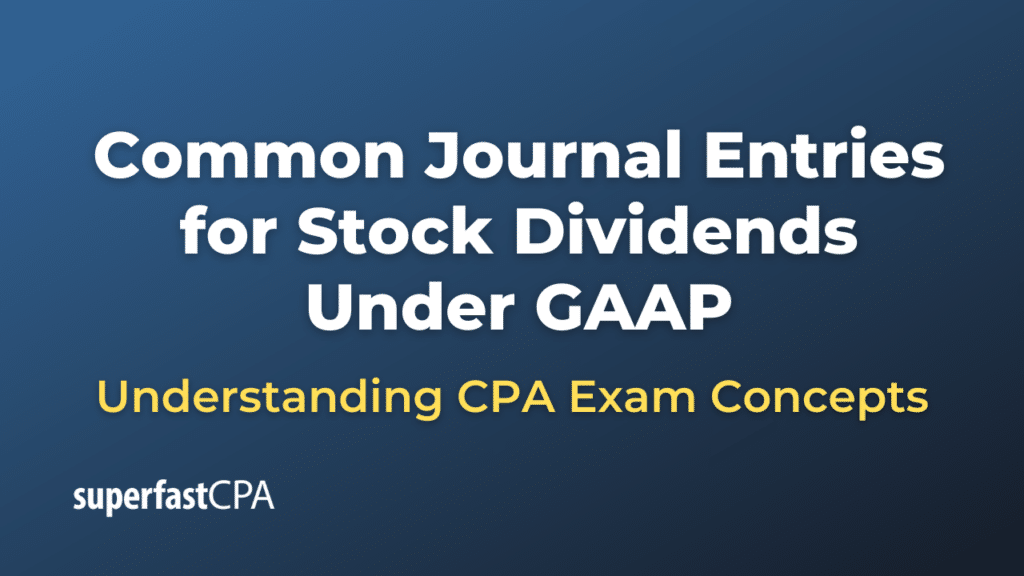Introduction
Brief Overview of Stock Dividends
In this article, we’ll cover common journal entries for stock dividends under GAAP. Stock dividends are a method by which companies reward their shareholders. Instead of distributing cash, companies issue additional shares of stock. This approach can be particularly attractive for companies looking to conserve cash while still providing value to their investors. When a company declares a stock dividend, it issues new shares to existing shareholders based on their current holdings. For example, in a 10% stock dividend, a shareholder with 100 shares would receive an additional 10 shares.
Stock dividends can be classified into two categories:
- Small Stock Dividends: Typically involve issuing additional shares amounting to less than 20-25% of the existing shares outstanding.
- Large Stock Dividends: Typically involve issuing additional shares amounting to more than 20-25% of the existing shares outstanding.
The primary effect of stock dividends is an increase in the number of shares outstanding, which can lead to a decrease in the share price, as the company’s market capitalization is spread over a larger number of shares.
Importance of Understanding Journal Entries for Stock Dividends
Accurate accounting for stock dividends is crucial for maintaining the integrity of a company’s financial records. Journal entries for stock dividends ensure that the financial statements reflect the correct distribution of shares and the corresponding changes in shareholders’ equity. Properly recorded journal entries help in:
- Maintaining accurate records of equity transactions.
- Providing transparency to shareholders and potential investors.
- Ensuring compliance with Generally Accepted Accounting Principles (GAAP).
Incorrect or incomplete journal entries can lead to misstated financial statements, which can mislead stakeholders and potentially result in regulatory penalties.
Objective of the Article
The objective of this article is to provide a comprehensive guide on the common journal entries required for stock dividends under GAAP. By understanding the detailed process and the specific entries required for both small and large stock dividends, accountants and financial professionals can ensure accurate and compliant financial reporting. This article will cover:
- The GAAP guidelines related to stock dividends.
- Step-by-step instructions for accounting for small and large stock dividends.
- Practical examples to illustrate the concepts.
- Common issues and best practices in accounting for stock dividends.
By the end of this article, readers will have a clear understanding of how to record stock dividends accurately, ensuring the integrity and transparency of their financial statements.
Understanding Stock Dividends
Definition and Purpose
Stock dividends are distributions of additional shares of a company’s stock to its existing shareholders. Instead of receiving cash, shareholders receive more shares in proportion to their current holdings. The primary purposes of issuing stock dividends are to:
- Conserve cash while rewarding shareholders.
- Signal confidence in the company’s future prospects.
- Increase the liquidity of the stock by increasing the number of shares outstanding.
Stock dividends are often used by companies with limited cash reserves or those that prefer to reinvest their earnings into the business rather than paying out cash dividends.
Types of Stock Dividends (Small vs. Large)
Stock dividends are generally categorized into two types based on the percentage of additional shares issued relative to the total shares outstanding:
Small Stock Dividends
- Definition: Small stock dividends involve issuing additional shares that amount to less than 20-25% of the existing shares outstanding.
- Accounting Treatment: These dividends are recorded at the fair market value of the shares on the declaration date.
- Example: If a company with 1,000,000 shares outstanding declares a 5% stock dividend, it will issue an additional 50,000 shares.
Large Stock Dividends
- Definition: Large stock dividends involve issuing additional shares that amount to more than 20-25% of the existing shares outstanding.
- Accounting Treatment: These dividends are recorded at the par value of the shares on the declaration date.
- Example: If a company with 1,000,000 shares outstanding declares a 30% stock dividend, it will issue an additional 300,000 shares.
Differences Between Stock Dividends and Cash Dividends
Understanding the differences between stock dividends and cash dividends is crucial for proper financial reporting and decision-making:
Stock Dividends
- Nature: Distribution of additional shares to existing shareholders.
- Impact on Cash Flow: No impact on cash flow, as no cash is distributed.
- Shareholder Equity: Increases the number of shares outstanding but does not change the total equity value. It reallocates amounts within equity accounts.
- Share Price: Typically results in a reduction in the share price, as the total market capitalization is spread over a larger number of shares.
- Purpose: Used to conserve cash, reward shareholders, and potentially signal positive future prospects.
Cash Dividends
- Nature: Distribution of cash to existing shareholders.
- Impact on Cash Flow: Reduces the company’s cash reserves.
- Shareholder Equity: Reduces retained earnings and total equity.
- Share Price: Share price may decrease on the ex-dividend date by the dividend amount, reflecting the cash outflow.
- Purpose: Directly returns profits to shareholders, providing immediate value.
By understanding these distinctions, companies can make informed decisions about their dividend policies, and accountants can accurately reflect these transactions in the financial statements.
GAAP Guidelines for Stock Dividends
Overview of Relevant GAAP Standards
The Generally Accepted Accounting Principles (GAAP) provide a framework for accounting for stock dividends to ensure consistency, transparency, and accuracy in financial reporting. The key standards related to stock dividends are primarily found in the Accounting Standards Codification (ASC) 505-20, which covers Equity and Stock Dividends.
Key Principles and Requirements
1. Measurement of Stock Dividends
- Small Stock Dividends: When a company issues a small stock dividend (typically less than 20-25% of the existing shares outstanding), GAAP requires that these dividends be measured and recorded at the fair market value of the shares on the declaration date.
- Large Stock Dividends: For large stock dividends (typically more than 20-25% of the existing shares outstanding), these are measured and recorded at the par value of the shares on the declaration date.
2. Accounting Entries
- Declaration Date:
- For small stock dividends, the journal entry involves debiting Retained Earnings for the fair value of the shares, crediting Common Stock Dividends Distributable at par value, and crediting Additional Paid-In Capital (APIC) for the excess of fair value over par value.
- For large stock dividends, the entry involves debiting Retained Earnings for the par value of the shares and crediting Common Stock Dividends Distributable.
- Distribution Date:
- On the distribution date, the journal entry for both small and large stock dividends is similar: debit Common Stock Dividends Distributable and credit Common Stock.
3. Disclosure Requirements
- GAAP mandates that companies disclose the nature and amount of dividends declared, including stock dividends, in the notes to the financial statements. This includes information about the type of stock dividend (small or large), the date of declaration, the date of distribution, and the number of shares issued.
Impact on Financial Statements
Stock dividends affect various components of a company’s financial statements:
1. Balance Sheet
- Shareholders’ Equity: Stock dividends reallocate amounts within the equity section without changing the total equity value. For small stock dividends, Retained Earnings are decreased by the fair value of the shares issued, while Common Stock and APIC increase. For large stock dividends, Retained Earnings are decreased by the par value of the shares issued, while Common Stock increases.
- Outstanding Shares: The number of shares outstanding increases, which can lead to a reduction in the book value per share.
2. Income Statement
- There is no direct impact on the income statement from issuing stock dividends, as they do not affect net income.
3. Statement of Cash Flows
- Stock dividends have no impact on the statement of cash flows because they do not involve any cash transactions.
4. Earnings Per Share (EPS)
- Stock dividends result in an increase in the number of shares outstanding, which dilutes the earnings per share (EPS). This dilution is accounted for in the calculation of both basic and diluted EPS.
Understanding and adhering to GAAP guidelines for stock dividends is crucial for accurate financial reporting. Properly accounting for stock dividends ensures that financial statements reflect the true financial position and performance of the company, maintaining the trust of investors and compliance with regulatory requirements. By following these guidelines, companies can provide clear and transparent information to their stakeholders.
Accounting for Small Stock Dividends
Definition and Criteria
Small stock dividends refer to the issuance of additional shares that amount to less than 20-25% of the existing shares outstanding. These dividends are typically used by companies to reward shareholders without using cash reserves. When a small stock dividend is declared, it is accounted for at the fair market value of the shares on the declaration date.
Journal Entries for Declaration and Distribution
Declaration Date
On the declaration date, the company recognizes the obligation to issue additional shares to its shareholders. The journal entry reflects the transfer from Retained Earnings to equity accounts (Common Stock Dividends Distributable and Additional Paid-In Capital) based on the fair value of the shares to be distributed.
Journal Entry:
- Debit: Retained Earnings (at fair value of shares to be distributed)
- Credit: Common Stock Dividends Distributable (at par value)
- Credit: Additional Paid-In Capital (for the excess of fair value over par value)
Distribution Date
On the distribution date, the company fulfills its obligation by issuing the additional shares. The journal entry records the transfer from Common Stock Dividends Distributable to Common Stock.
Journal Entry:
- Debit: Common Stock Dividends Distributable
- Credit: Common Stock
Example with Step-by-Step Calculations and Journal Entries
Scenario:
A company has 1,000,000 shares outstanding with a par value of $1 per share and a current market value of $10 per share. The company declares a 10% stock dividend.
- Calculate the Number of Shares to be Issued:
- 1,000,000 shares × 10% = 100,000 additional shares
- Calculate the Fair Value of the Shares to be Issued:
- 100,000 shares × $10 (market value per share) = $1,000,000
- Calculate the Par Value of the Shares to be Issued:
- 100,000 shares × $1 (par value per share) = $100,000
- Calculate the Additional Paid-In Capital:
- Fair value of shares to be issued – Par value of shares to be issued
- $1,000,000 – $100,000 = $900,000
Journal Entries:
Declaration Date:
- Debit: Retained Earnings $1,000,000
- Credit: Common Stock Dividends Distributable $100,000
- Credit: Additional Paid-In Capital $900,000
Distribution Date:
- Debit: Common Stock Dividends Distributable $100,000
- Credit: Common Stock $100,000
Step-by-Step Breakdown:
- Declaration Date:
- The company reduces Retained Earnings by the fair value of the shares to be distributed ($1,000,000).
- It recognizes a liability (Common Stock Dividends Distributable) for the par value of the shares ($100,000).
- The excess of the fair value over the par value ($900,000) is credited to Additional Paid-In Capital.
- Distribution Date:
- The company eliminates the liability (Common Stock Dividends Distributable) by debiting it for $100,000.
- It increases the Common Stock account by the par value of the shares issued ($100,000).
By following these steps and making the appropriate journal entries, the company ensures accurate accounting for the issuance of small stock dividends, maintaining the integrity of its financial statements.
Accounting for Large Stock Dividends
Definition and Criteria
Large stock dividends refer to the issuance of additional shares that amount to more than 20-25% of the existing shares outstanding. These dividends are often used to significantly increase the number of shares in circulation, which can enhance liquidity. When a large stock dividend is declared, it is accounted for at the par value of the shares on the declaration date.
Journal Entries for Declaration and Distribution
Declaration Date
On the declaration date, the company recognizes the obligation to issue additional shares to its shareholders. The journal entry reflects the transfer from Retained Earnings to Common Stock Dividends Distributable based on the par value of the shares to be distributed.
Journal Entry:
- Debit: Retained Earnings (at par value of shares to be distributed)
- Credit: Common Stock Dividends Distributable (at par value)
Distribution Date
On the distribution date, the company fulfills its obligation by issuing the additional shares. The journal entry records the transfer from Common Stock Dividends Distributable to Common Stock.
Journal Entry:
- Debit: Common Stock Dividends Distributable
- Credit: Common Stock
Example with Step-by-Step Calculations and Journal Entries
Scenario:
A company has 1,000,000 shares outstanding with a par value of $1 per share. The company declares a 30% stock dividend.
- Calculate the Number of Shares to be Issued:
- 1,000,000 shares × 30% = 300,000 additional shares
- Calculate the Par Value of the Shares to be Issued:
- 300,000 shares × $1 (par value per share) = $300,000
Journal Entries:
Declaration Date:
- Debit: Retained Earnings $300,000
- Credit: Common Stock Dividends Distributable $300,000
Distribution Date:
- Debit: Common Stock Dividends Distributable $300,000
- Credit: Common Stock $300,000
Step-by-Step Breakdown:
- Declaration Date:
- The company reduces Retained Earnings by the par value of the shares to be distributed ($300,000).
- It recognizes a liability (Common Stock Dividends Distributable) for the par value of the shares ($300,000).
- Distribution Date:
- The company eliminates the liability (Common Stock Dividends Distributable) by debiting it for $300,000.
- It increases the Common Stock account by the par value of the shares issued ($300,000).
By following these steps and making the appropriate journal entries, the company ensures accurate accounting for the issuance of large stock dividends, maintaining the integrity of its financial statements.
Comparison Between Small and Large Stock Dividends
Key Differences in Accounting Treatment
The accounting treatment for small and large stock dividends differs primarily in the valuation of the shares distributed and the impact on the financial statements. Here are the key differences:
Valuation Basis
- Small Stock Dividends: Accounted for at the fair market value of the shares on the declaration date.
- Large Stock Dividends: Accounted for at the par value of the shares on the declaration date.
Impact on Retained Earnings
- Small Stock Dividends: Retained Earnings is reduced by the fair value of the shares issued.
- Large Stock Dividends: Retained Earnings is reduced by the par value of the shares issued.
Additional Paid-In Capital (APIC)
- Small Stock Dividends: The difference between the fair value and the par value of the shares is credited to APIC.
- Large Stock Dividends: There is no impact on APIC since the entire amount is recorded at par value.
Disclosure Requirements
- Small Stock Dividends: Requires disclosure of the fair value per share at the time of declaration.
- Large Stock Dividends: Requires disclosure of the par value per share at the time of declaration.
Examples Highlighting These Differences
Example for Small Stock Dividends
Scenario:
A company has 1,000,000 shares outstanding with a par value of $1 per share and a current market value of $10 per share. The company declares a 10% stock dividend.
Calculations:
- Shares to be Issued: 1,000,000 shares × 10% = 100,000 shares
- Fair Value of Shares: 100,000 shares × $10 = $1,000,000
- Par Value of Shares: 100,000 shares × $1 = $100,000
- APIC: $1,000,000 – $100,000 = $900,000
Journal Entries:
Declaration Date:
- Debit Retained Earnings $1,000,000
- Credit Common Stock Dividends Distributable $100,000
- Credit Additional Paid-In Capital $900,000
Distribution Date:
- Debit Common Stock Dividends Distributable $100,000
- Credit Common Stock $100,000
Example for Large Stock Dividends
Scenario:
A company has 1,000,000 shares outstanding with a par value of $1 per share. The company declares a 30% stock dividend.
Calculations:
- Shares to be Issued: 1,000,000 shares × 30% = 300,000 shares
- Par Value of Shares: 300,000 shares × $1 = $300,000
Journal Entries:
Declaration Date:
- Debit Retained Earnings $300,000
- Credit Common Stock Dividends Distributable $300,000
Distribution Date:
- Debit Common Stock Dividends Distributable $300,000
- Credit Common Stock $300,000
Highlighting Differences
- Valuation:
- Small stock dividends use the fair market value ($10 per share in the example).
- Large stock dividends use the par value ($1 per share in the example).
- Impact on Retained Earnings:
- For the small stock dividend, Retained Earnings is reduced by the fair value of $1,000,000.
- For the large stock dividend, Retained Earnings is reduced by the par value of $300,000.
- APIC:
- Small stock dividends include an APIC credit for the difference between fair value and par value ($900,000 in the example).
- Large stock dividends do not impact APIC as the entire value is recorded at par.
These differences in accounting treatment highlight the importance of accurately categorizing and valuing stock dividends according to GAAP guidelines to ensure precise financial reporting.
Practical Considerations and Common Issues
Timing and Frequency of Stock Dividends
Timing
The timing of declaring and distributing stock dividends is crucial for both the company and its shareholders. Companies often declare stock dividends during periods of strong financial performance to signal confidence in their future growth. Timing considerations include:
- Quarterly Earnings Announcements: Aligning stock dividends with quarterly earnings can emphasize positive financial results.
- Annual General Meetings: Declaring stock dividends during annual meetings can highlight the company’s commitment to shareholder value.
- Strategic Financial Planning: Timing stock dividends to align with strategic initiatives, such as expansion or mergers, can reinforce the company’s growth narrative.
Frequency
The frequency of stock dividends can vary based on the company’s financial strategy and market conditions:
- Regular Dividends: Some companies may issue stock dividends on a regular basis, similar to cash dividends, to provide consistent rewards to shareholders.
- Occasional Dividends: Others may issue stock dividends sporadically, depending on specific financial circumstances or strategic decisions.
- One-Time Dividends: Special one-time stock dividends can be issued during exceptional financial performance or significant corporate events.
Impact on Shareholders’ Equity
Stock dividends impact the equity section of the balance sheet by reallocating amounts within shareholders’ equity without changing the total equity value. The specific impacts include:
Increase in Outstanding Shares
Issuing stock dividends increases the number of shares outstanding, which can enhance liquidity and potentially attract more investors.
Retained Earnings
- Small Stock Dividends: Retained Earnings is reduced by the fair value of the shares issued, reflecting the transfer of value to shareholders.
- Large Stock Dividends: Retained Earnings is reduced by the par value of the shares issued, representing a smaller reduction compared to small stock dividends.
Common Stock and APIC
- Small Stock Dividends: Increase in Common Stock (at par value) and Additional Paid-In Capital (APIC) for the excess of fair value over par value.
- Large Stock Dividends: Increase in Common Stock (at par value) with no impact on APIC.
Common Mistakes and How to Avoid Them
Incorrect Valuation
Mistake: Misvaluing the shares issued in a stock dividend, either by using the wrong market value or par value.
Solution: Ensure accurate and up-to-date market values are used for small stock dividends and the correct par value is applied for large stock dividends.
Misclassification
Mistake: Incorrectly classifying the size of the stock dividend (small vs. large), leading to improper accounting treatment.
Solution: Carefully assess the percentage of the stock dividend relative to the total shares outstanding to determine the correct classification.
Incomplete Journal Entries
Mistake: Failing to record all necessary journal entries for the declaration and distribution dates.
Solution: Follow GAAP guidelines meticulously and double-check that all required entries are recorded accurately and completely.
Inadequate Disclosure
Mistake: Not providing sufficient disclosure in the financial statements regarding the nature and amount of stock dividends.
Solution: Include detailed notes in the financial statements, outlining the declaration date, distribution date, number of shares issued, and valuation method used.
Impact on EPS
Mistake: Overlooking the impact of increased shares on earnings per share (EPS) calculations, leading to inaccurate financial metrics.
Solution: Recalculate both basic and diluted EPS after issuing stock dividends to reflect the increased number of shares outstanding accurately.
By being mindful of these practical considerations and avoiding common mistakes, companies can effectively manage stock dividends and maintain the accuracy and integrity of their financial reporting.
Real-World Examples and Case Studies
Analysis of Stock Dividend Practices by Well-Known Companies
Apple Inc.
Apple Inc. has a history of returning value to shareholders through stock dividends and splits. In June 2014, Apple issued a 7-for-1 stock split, which, while technically a stock split rather than a dividend, showcases how the company increases liquidity and makes its shares more accessible to a broader range of investors. This move was well-received by the market and highlighted Apple’s commitment to shareholder value.
Microsoft Corporation
Microsoft has also engaged in stock dividends as part of its capital management strategy. In the early 2000s, Microsoft issued a 2-for-1 stock split, effectively doubling the number of shares outstanding. This approach helped to maintain an attractive share price for retail investors and signaled confidence in the company’s long-term growth prospects.
Coca-Cola Company
Coca-Cola is known for its consistent dividend policy, including occasional stock dividends. For instance, Coca-Cola issued a 2-for-1 stock split in 2012. This practice aligns with the company’s strategy of providing consistent returns to shareholders while maintaining flexibility in its capital structure.
Lessons Learned from These Examples
Enhancing Liquidity and Accessibility
One key lesson from these examples is that issuing stock dividends can significantly enhance the liquidity of a company’s shares. By increasing the number of shares outstanding, companies like Apple and Microsoft made their stock more accessible to a broader range of investors, which can help stabilize share prices and improve marketability.
Signaling Confidence and Stability
Stock dividends can also serve as a signal of confidence in the company’s future performance. When well-established companies like Coca-Cola issue stock dividends, it reassures investors of the company’s stability and growth prospects. This signaling effect can positively influence investor sentiment and market perception.
Maintaining Attractive Share Prices
Keeping share prices at an attractive level for retail investors is another strategic benefit of stock dividends. By issuing additional shares, companies can reduce the per-share price, making it easier for smaller investors to buy and trade shares. This approach can broaden the investor base and enhance market activity.
Managing Capital Structure
Stock dividends provide a flexible tool for managing a company’s capital structure. They allow companies to reward shareholders without depleting cash reserves, preserving liquidity for other strategic initiatives. This flexibility is particularly valuable for companies aiming to balance shareholder returns with investments in growth opportunities.
Importance of Clear Communication and Disclosure
Effective communication and clear disclosure are crucial when issuing stock dividends. Investors need to understand the reasons behind the dividend, its impact on their holdings, and any changes in the company’s financial metrics. Transparent communication helps maintain investor trust and ensures that the stock dividend is perceived positively.
By examining the practices of well-known companies, it becomes clear that stock dividends are a versatile tool in corporate finance. They can enhance liquidity, signal confidence, maintain attractive share prices, and manage capital structure effectively. However, successful implementation requires careful planning, accurate accounting, and transparent communication to fully realize these benefits.
Conclusion
Summary of Key Points
Throughout this article, we have explored the intricacies of accounting for stock dividends under Generally Accepted Accounting Principles (GAAP). Key points covered include:
- Understanding Stock Dividends: Stock dividends are a method of rewarding shareholders through the issuance of additional shares rather than cash. They can be categorized as small (less than 20-25% of outstanding shares) or large (more than 20-25% of outstanding shares).
- GAAP Guidelines: GAAP provides clear guidelines for accounting for stock dividends, with small stock dividends being recorded at fair market value and large stock dividends at par value.
- Journal Entries: We discussed the necessary journal entries for both small and large stock dividends, including the declaration and distribution dates.
- Practical Considerations: The timing, frequency, and impact on shareholders’ equity were examined, along with common mistakes to avoid.
- Real-World Examples: Analysis of stock dividend practices by companies like Apple, Microsoft, and Coca-Cola highlighted best practices and strategic benefits.
Importance of Accurate Journal Entries for Stock Dividends
Accurate journal entries for stock dividends are crucial for several reasons:
- Financial Integrity: Properly recorded journal entries ensure the financial statements accurately reflect the company’s financial position and performance.
- Compliance: Adhering to GAAP guidelines helps maintain regulatory compliance and avoids potential penalties or restatements.
- Investor Confidence: Transparent and accurate financial reporting builds trust with investors, demonstrating the company’s commitment to high standards of corporate governance.
- Operational Efficiency: Correct journal entries streamline financial processes and reduce the risk of errors, saving time and resources in the long run.
Final Thoughts and Recommendations
Stock dividends are a powerful tool for companies to reward shareholders, manage capital structure, and signal confidence in their future prospects. However, the benefits of stock dividends can only be fully realized through meticulous planning, accurate accounting, and clear communication.
Recommendations:
- Stay Informed: Keep abreast of the latest GAAP updates and best practices for accounting for stock dividends.
- Invest in Training: Ensure that accounting and finance teams are well-trained in handling stock dividend transactions.
- Use Technology: Leverage accounting software to automate and validate journal entries, reducing the risk of human error.
- Communicate Clearly: Provide comprehensive disclosures in financial statements and communicate the rationale and impact of stock dividends to investors effectively.
By following these recommendations, companies can effectively manage stock dividends, enhance their financial reporting, and build stronger relationships with their shareholders. Accurate and transparent accounting for stock dividends not only ensures regulatory compliance but also reinforces investor confidence and supports the company’s strategic objectives.
Appendices
Additional Resources and References
GAAP Standards and Guidance
- Accounting Standards Codification (ASC) 505-20: This section of the ASC provides comprehensive guidance on equity and stock dividends, detailing the accounting treatment for both small and large stock dividends.
- ASC 505-20 Overview
- Financial Accounting Standards Board (FASB): The FASB website offers access to the full Accounting Standards Codification, updates on new accounting standards, and additional resources for understanding GAAP requirements.
- FASB Official Website
Educational Resources
- American Institute of CPAs (AICPA): The AICPA provides a wealth of resources, including publications, webinars, and courses on various accounting topics, including stock dividends.
- AICPA Learning and Development
- Chartered Financial Analyst (CFA) Institute: The CFA Institute offers articles, research papers, and courses on financial reporting and analysis, which can help deepen your understanding of stock dividends and other financial instruments.
- CFA Institute Learning Resources
Practical Tools and Templates
- Excel Templates for Journal Entries: Many accounting firms and educational websites offer free Excel templates to help you record journal entries accurately. These templates can be customized to fit your specific needs.
- AccountingCoach Journal Entry Templates
- Sample Financial Statements: Reviewing sample financial statements from publicly traded companies can provide practical insights into how stock dividends are reported and disclosed.
- SEC EDGAR Database
Further Reading
- “Intermediate Accounting” by Kieso, Weygandt, and Warfield: This textbook provides an in-depth explanation of accounting principles, including detailed sections on stock dividends and shareholders’ equity.
- Intermediate Accounting Textbook
- “Financial Reporting and Analysis” by Revsine, Collins, Johnson, and Mittelstaedt: Another excellent resource for understanding the intricacies of financial reporting, with practical examples and case studies.
- Financial Reporting and Analysis Textbook
By utilizing these additional resources and references, you can deepen your understanding of the accounting for stock dividends, stay updated on the latest GAAP guidelines, and access practical tools to enhance your financial reporting accuracy.









